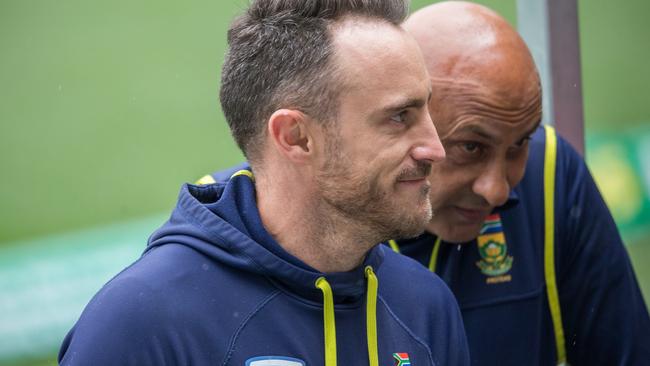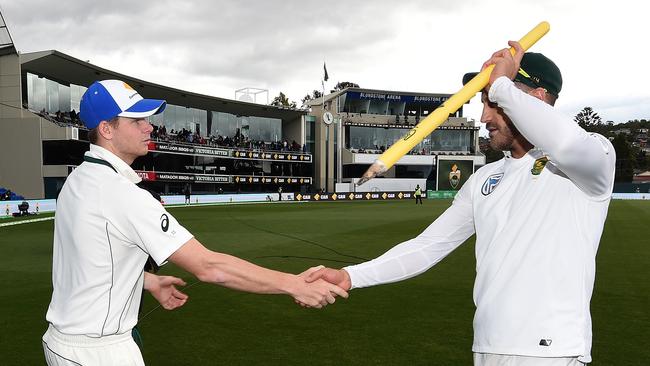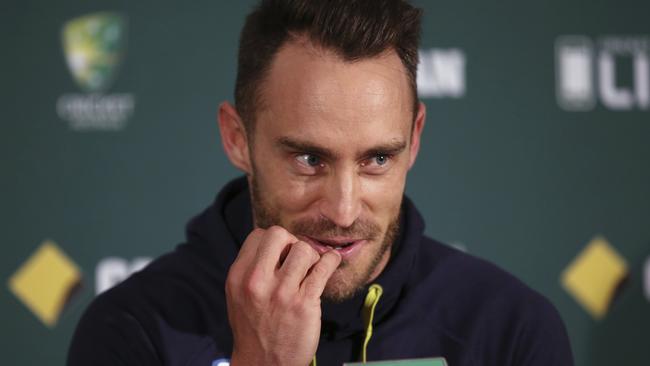Cricket’s dirty little secret: Has ball tampering been ignored for too long?
Who would have thought the Hobart Test debacle of 2016 would later spark an international event which would smear Australian cricket with so much global ridicule, writes Peter Lalor.
Cricket
Don't miss out on the headlines from Cricket. Followed categories will be added to My News.
How do you beat a team that cheats?
That was the question abroad in certain quarters of Australian cricket as it contemplated a Test series in 2018 against a South African side they had been convinced were ball tampering in Port Elizabeth 2014, and who had been caught doing it in Hobart in 2016.
The more accurate question was, how do you beat a side that is better at cheating than you are. One that is shameless about it?
Australia had been soundly thrashed in the 2014 Port Elizabeth and 2016 Hobart Tests.
Faf du Plessis was caught and convicted of ball tampering and given a slap on the wrist by the ICC. The home team, however, was given a cuff over the ears by the suits in Australian cricket who flew into town and read the riot act.
The Australian brass made it clear that losing was not an option and five players were dropped from the underperforming side.

Ball tampering has always been part of cricket. Those that wore the baggy green before had no right to claim any high moral ground. There was footage of an Australian player scratching the ball with his thumb nail in 2012 which mysteriously disappeared when questions were asked.
Chris Broad, who is match referee in Adelaide, was pushed by the visitors to investigate and uncover evidence of ball tampering in that match.
He found none.
“During the tea interval on that day, I spoke with Australia coach Mickey Arthur and told him that the umpires will continue to inspect the cricket ball regularly, and monitor the actions of all players,” Broad said.
“In the opinion of the umpires, there was no evidence to suggest that the condition of the ball was changed, or that the video or photographic evidence would support a charge under the Code of Conduct, so they will not be laying any charges relating to these incidents.”
They didn’t see what I saw and they probably didn’t want to because it was the game’s dirty little secret.
Note how Broad entered the rooms and told the side they were being watched. Australian team management denied that to The Australian when asked.
The second law of ball tampering is the blanket denial and the third is an official lack of interest from officials.
The last thing umpires or the ICC want are ball tampering scandals. Essentially they have a don’t-ask, don’t-tell policy in the game.
Ball tampering and the antecedents that led to the sandpaper scandal in 2018 is an issue that is at once black and white in its simplicity, and at the same time confounding in its nuances.
“In all my time in Australian cricket I was never once given an instruction or permission to tamper with the ball,” a player from that time told The Australian.

Some in management and the coaching staff can, however, be accused of the very crime Steve Smith was.
They turned away. They didn’t want to know or they shrugged and said “you are paid to win … you work out how that happens”.
Du Plessis boasts in his new book about being the player who led to zippers being banned from uniforms and mints specifically outlawed from the “ball shining” process — the spin is his.
We are back, like a dog revisiting its own vomit, after James Erskine threw petrol on the ball tampering bin fire on Thursday with a shocking allegation.
“Two senior executives were in the changing room in Hobart (in 2016) and basically were berating the team for losing against South Africa — and Warner said that we’ve got to reverse swing the ball and the only way we can reverse swing the ball is basically by tampering with it — and so they were told to do it,” Erskine said on radio.
Those there have a different memory. There’s a seed of truth in what he says but it is not a totally accurate representation of events.
Current Cricket Australia chief executive Nick Hockley referred to the comments as “unhelpful and unfounded”.

The truth is that players weren’t told to tamper with the ball, but they were never told not to.
Five players lost their jobs after that defeat at the hands of a South African side in 2016.
Peter Nevill, Adam Voges, Callum Ferguson and Joe Mennie never played for their country again. Selector Rod Marsh stood down from his job.
“We pay you to win” was the famous quote attributed to then chief executive James Sutherland sometime earlier by Ricky Ponting and one that hasn’t been denied.
Sutherland was not licensing anyone to tamper with the ball and would not, but there were others caught under the strain of a performance-based system that demanded results.
In an extraordinary turn of events Sutherland and high performance manager Pat Howard had flown down to berate the side for its performance in Hobart.
Warner did ask what they were expected to do against a side that had an illicit mastery over reverse swing. At least one who was brazen about it.

Warner had a bitter experience with the officials over ball tampering on the South African tour in 2014.
The opening batsman had been a bit too honest on Sydney radio the day after Australia were beaten by a South African side which had the ball reversing when its opponents could not.
“We were actually questioning whether or not AB de Villiers would get the ball in his hand and with his glove wipe the rough side every ball. That’s another thing we have to try and bring up with the umpires,” Warner said.
The ICC match referee, Roshan Mahanama, moved swiftly when he heard about the allegations.
After a quick inquiry he fined Warner $2900.
Ahead of the 2018 tour questions about how to beat a team that is better at ball tampering hung in the air before the team even left these shores.
Tim Paine addressed the sandpaper scandal in his book The Price Paid (which I ghosted).
“Every team tampers with the ball to some degree, especially when they’re looking for reverse swing,” he wrote.

“They throw it into the square, they ‘manage’ it like scientists in a lab, nobody with sweaty hands can touch it, only certain fielders apply the saliva, some spinners aren’t allowed near it because they have clammy hands. Fielders have to return the ball a certain way. If it bounces on the wrong side, heaven help them.
“Throwing it into the rough is against the rules and if you are too obvious the umpires will have a go at you, but it’s hard to police and in most people’s minds it’s not a big deal. Umpires never seem too keen on stamping it out, in fact they rarely want to make a big deal of any of this stuff.
“In state and international cricket a lot of things go down that the officials turn a blind eye to. A lot of the umpires have played cricket at a senior level and know it is an unspoken part of it.
“Match referees sometimes tell teams to pull their heads in but it rarely gets more serious than a verbal warning.
“So much of it goes on and nobody admits to it. People do what they can and everybody moans about the other side doing it, but there are no cleanskins in cricket and there weren’t in that game.”
Paine alleges the South Africans were up to it in the fourth Test and that he made a complaint to the umpires.
“We went to the umpires about it, which might seem a bit poor, but we’d been slaughtered and were convinced they’d been up to it since the first Test. But the footage got lost. As it would.”
More Coverage
Originally published as Cricket’s dirty little secret: Has ball tampering been ignored for too long?





